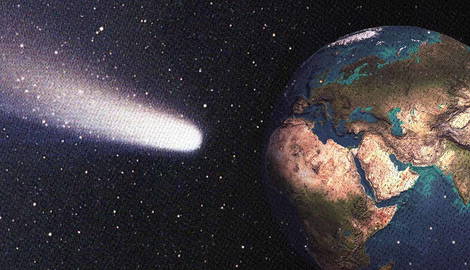
While the return of Halley’s Comet incited a new sense of panic in 1910, it was not the first time it had been observed from Earth. Halley’s Comet is named after the English astronomer Edmond Halley, who was able to predict the return of the comet in 1785. It later came back in 1835, with a future return date in 1910. Although there is evidence in history of the comet being seen earlier, Halley was the first one to realize that it was the same comet that kept returning and was able to calculate its orbit.
First Sighting

The first documented sighting of Halley’s Comet is disputed to be is as far back as 5th century BCE by the Greeks or in the 3rd century B.C.E by Chinese astronomers. Potential records of the comet in historical texts and art continue to offer speculation, including whether a painting by Italian Giotto depicted the comet in the sky.
One well documented occurrence of Halley’s Comet was in 1066 and involved William the Conqueror. William the Conqueror was King of England, notably the first Norman King after a successful invasion that was recorded in the Bayeux Tapestry – an embroidered cloth almost 230’ by 2’. He is said to have thought that the comet signaled his coming 1066 victory, and it was notable enough for it to be embroidered into the Bayeux Tapestry.
Setting the Stage in 1910

As the date approached, many began to wonder what the comet’s impact would be when it passed by. Some newspapers offered sensational speculation which sent people into a panic. What would happen if the comet collided with earth? Scientists were quick to assure people that this would not occur, however they had their own hypotheses. According to the Library of Congress the initial news circulated about the comet in September 1909.
In February 1910 French astronomer and writer Nicolas Camile Flammarion, who was sometimes influenced not just by science but science fiction, was widely reported as stating to newspapers in multiple countries including the United States that there would be devastating consequences. He said the tail of the comet would pass through Earth’s atmosphere, and toxic gasses could “snuff out all life on the planet.” Later he reported that it would be “improbable” and that the tail of a comet is too insignificant to do any damage and that it was an interesting “thought experiment” on what could happen if there were poisonous gases in the atmosphere.
As many newspapers chose to only to print the sensational part, rather than his correction, it led to many believing that the scientist was predicting the end of the world sometime between April-May 1910 when Halley’s Comet would complete its orbit near Earth and be visible.
Preventative Measures

The panic that deadly gases could somehow enter Earth’s atmosphere started over the knowledge that the tail of Halley’s Comet contained cyanogen, a very deadly gas. As with any tragedy or impending disaster – real or assumed – there will be people waiting to take advantage of the ensuing panic. Con men began selling pills and elixirs that claimed to be able to deal with the negative affects of the comet. This included two men from Texas who marketed sugar pills as a cure all who were arrested for a short period before being released. One advertised anti-comet medication said it was “an elixir for escaping the wrath of the heavens”. Of course, at best these tonics and pills were placebos and simple sugar pills and water with some things mixed in. At worst, there was a danger in not knowing their chemical makeup.
The response to the potential deadly fumes of the comet had a similar outcome to other national disasters or pandemics. People were trying to make their homes safer by stuffing cracks including keyholes so vapors would not get in. Different churches also became busier as more people came into services to receive forgiveness and get penance before the end of the world. One of the “best” ideas came in the form of an anti-comet umbrella that would somehow keep the user safe from the comet and the residue it would “give off” as it passed by Earth.
Positive Media

Not all the products that were sold related to the comet were negative or intended to “save” people from sickness or death. Some were simply using the vent for some creative advertising, in the same way that many different limited-edition items, branding, drinks, and food were named or related to the 2024 eclipse. Bird’s Custard, a powder that can cook into a curdle-free sauce, and Pears’ Soap both used the comet as advertisement for their products.
The Bird’s Custard advertisement features the illustration of a comet streaking towards Earth, saying, “Bird’s Custard Attracts the World!” Meanwhile, Pears’ soap is slightly more detailed. Their ad states, “Halley’s Comet appears but once in seventy-five years, Pear’s Soap is visible day and night every day of the year all over the world.” The advertisement ran in Red Book Magazine, in their April 1910 issue.
Halley’s Comet Today

Halley’s Comet went by in 1910 without creating any Earth-ending disasters. Instead, it became recognized an awe-inspiring event. The orbit around the sun makes it a rare occurrence within a lifetime, and it continues to be the only short-term comet that can be seen without the aid of a telescope from Earth. In 1986, technology had advanced enough to allow a more in-depth picture of it from space.
Missions and research have been planned for when the comet’s orbit brings it close to Earth. NASA had planned that the Space Shuttle Challenger’s mission would study the comet, although it did not take place due to the tragic explosion on January 28, 1986, after liftoff. It remains to be seen what sort of tests or imaging will be planned in the future when Halley’s Comet graces our presence once again. Hopefully, this time we will avoid the drama and sensationalist news, in favor of a more positive outlook.










